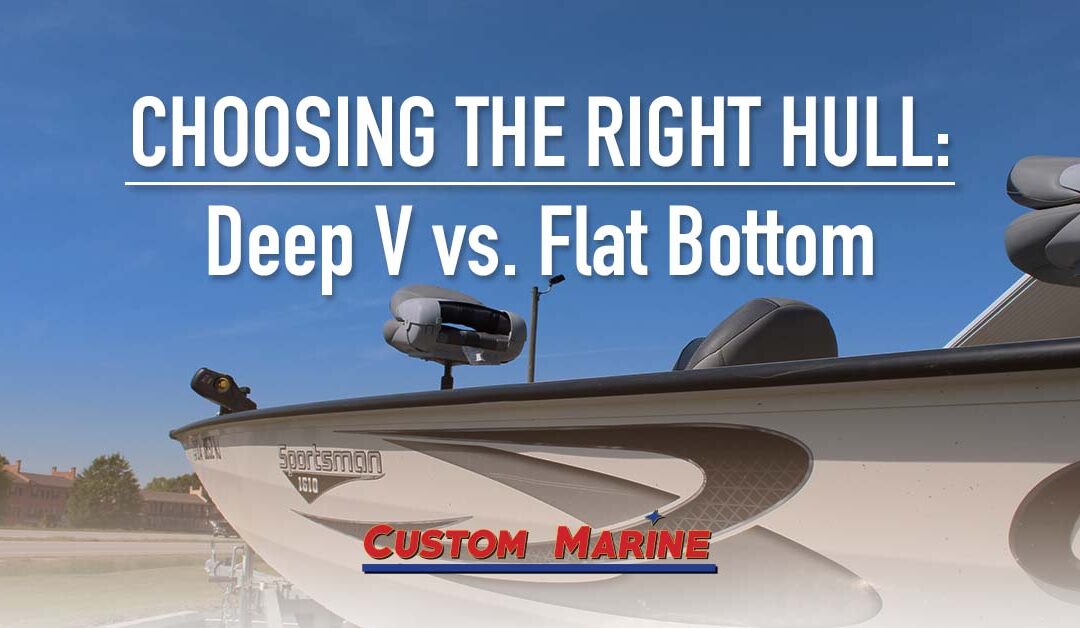If you’re in the market for a boat, consider what type of hull will fit your boating lifestyle best. The four common types of boat hulls include; flat-bottom hulls, round-bottom hulls, v-shaped hulls, and multi-hulled. Despite the variety, all boat hulls are designed to do one of two things: displace water or ride on top of it.
Of these hull types, two are considered the more popular for fishermen and cruisers alike, the flat-bottomed hull and the deep v hull. When choosing between a flat bottom boat hull or a deep v boat hull, there are significant disadvantages and advantages. These boat hulls are trendy choices but are also the opposite in design.
Flat Bottom Hull
Flat-bottomed hulls are typically found on bay boats, made out of aluminum, and specialized for shallow water with features such as a raised bow, ample deck space, and a cockpit. These boats are designed to ride on top of the water, also called ‘planing.’ Flat bottom boats are frequently referred to as “jon” boats and popularly used for water sports such as fishing and waterskiing because the shape creates a smooth wake, almost no dead rise, and maximum stability. A flat-bottomed boat will typically only accommodate low horsepower engines or trolling motors.
Advantages:
- Operates best in calm bodies of water
- Lightweight and very stable
- Easily maneuverable
- Large deck space
Disadvantages:
- Not designed for offshore fishing, choppy seas, or harsh weather conditions because you risk losing balance or falling off with nothing to hold onto
- Once stepping down from the raised bow deck into the cockpit, someone may feel claustrophobic in a small area.
- In big seas, large waves have the potential to come over the side of the low gunnels of the boat, making for a not-so-dry ride.
The opposite of a flat bottom is a deep-v. Boats with deep-v hulls are designed with a wedge shape from bow to stern with a more pronounced dead rise, created for high speeds. These boats are some of the most specialized watercraft on the market, popular among deep-sea or off-shore fishermen for their smooth ride in rough water. The deep-v hull ride is smoother in choppy waters at high speeds and cuts through waves rather than take a pounding. Deep-V hulled boats also have added drafts, making these vessels less stable at slower speeds and in shallower waters.
Advantages:
- From bow to stern, can walk around without any obstruction
- V-shaped hull cuts through the water, making for a smoother ride in choppy and deeper waters
- Added security with taller gunnels
- Sprays water outwards
Disadvantages:
- More power is needed
- Cannot run in super shallow water
- Cannot fit in highly shallow waters
If you only desire to stay on shore, hit the sandbar, do some inshore fishing, and don’t care to veer offshore, a flat-bottomed hull or a bay boat may be the best choice. Boaters can stay in shallow waters and don’t have to worry about getting stuck.
Unfortunately, with a flat bottom boat, it will not ride as well in deep water because you will loose dead rise.
While a deep V boat can’t take you as far into shallow waters or stay as stable in calm waters as a flat bottom boat, they deal with choppy water far better than flat bottoms.
In addition to having what it takes to brave choppy waters, a deep V boat will keep you much drier.
At Custom Marine, we have an excellent selection of hulls for you to choose from, and our sales team of experts is prepared to help you make the right decision based on your needs.

